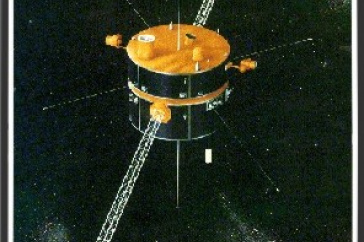The University of New Hampshire is a flagship research university that inspires innovation and transforms lives in our state, nation and world. More than 16,000 students from all 50 states and 71 countries engage with an award-winning faculty in top ranked programs in business, engineering, law, health and human services, liberal arts and the sciences across more than 200 programs of study. UNH’s research portfolio includes partnerships with NASA, NOAA, NSF and NIH, receiving more than $100 million in competitive external funding every year to further explore and define the frontiers of land, sea and space.
UNH Researcher Identifies Key Differences in Solar Wind Models

Researchers used data from NASA’s WIND spacecraft project to identify differences in solar wind models.
Photo Credit: NASA
DURHAM, N.H. – The challenge of predicting space weather, which can cause issues with telecommunications and other satellite operations on Earth, requires a detailed understanding of the solar wind (a stream of charged particles released from the sun) and sophisticated computer simulations. Research done at the University of New Hampshire has found that when choosing the right model to describe the solar wind, using the one that takes longer to calculate does not make it the most accurate.
In the study, published in The Astrophysical Journal, Daniel Verscharen, a research assistant professor in physics at UNH’s Space Science Center, compared two commonly used theoretical descriptions, kinetic theory versus magnetohydrodynamics (MHD), when measuring the behavior of turbulence in the solar wind. Kinetic theory looks at the solar wind as a composition of rapidly moving particles and uses very complicated mathematical methods that require long periods of time when evaluated on sophisticated super computers. The second description, MHD, views the solar wind as being a fluid, or more gas-like, and is much less complicated to calculate. Surprisingly, the study showed that it was the MHD, the model that was faster to calculate, that delivered the more precise predictions.
“Our research found that it makes a huge difference which model is used,” said Verscharen. “We found that the much faster computed MHD models may actually capture some of the solar-wind behavior a lot better than expected. This is a very important result for solar-wind modelers because it may justify the application of MHD, based on first principles and observations.”
To prove his theory, Verscharen collected data taken from the WIND spacecraft, which is currently orbiting in the solar wind, from study co-authors Christopher Chen at the Imperial College London and Robert Wicks from University College London. After comparing the theory with the actual spacecraft data, the team found that the type of disturbance they were investigating behaved a lot more like a fluid than a kinetic medium with collisionless particles. This was unexpected because they believed that the kinetic theory should work much better in a gas as dilute, or thin, as the solar wind.
The finding could lead to a more efficient way to forecast space weather for institutions that need to continually model the solar wind, like NASA. Severe space weather can cause satellite and communication failures, GPS loss, power outages, and can even have effects on commercial airlines and space flight. In order to forecast the effects that solar wind plasma and energetic particles might have on these systems, modelers currently run different computer simulations and compare the results. Verscharen and his team believe that their findings could help develop a set of criteria to determine which type of modeling would be most appropriate for their prediction efforts in specific situations.
“If the solar-wind parameters were a certain way, they could use MHD modeling and if not, they might be better to perform simulations based on kinetic theory,” said Verscharen. “It would just provide a more efficient way to predict space weather and the solar wind.”
It is still not understood why the solar wind behaves like a fluid. The researchers hope future studies will determine under which conditions the solar wind can be modeled as a fluid with MHD, and when a kinetic model would be necessary.
This research was supported by NASA, a National Science Foundation SHINE grant, and the United Kingdom Science and Technology Facilities Council.
PHOTO FOR DOWNLOAD:
https://www.unh.edu/unhtoday/sites/default/files/media/wind.jpg
Caption: Researchers used data from NASA’s WIND spacecraft project to identify differences in solar wind models.
Photo Credit: NASA
Latest News
-
Research Finds Rural Americans Carry Heavy Burden Accessing Social Security Benefits and InformationMarch 27, 2025
-
March 25, 2025
-
March 17, 2025
-
March 12, 2025
-
February 19, 2025















































